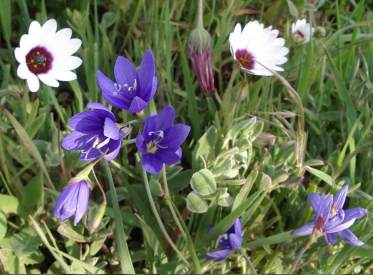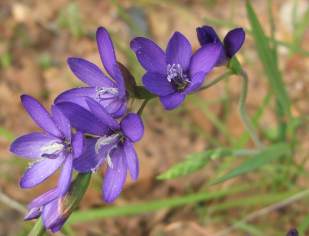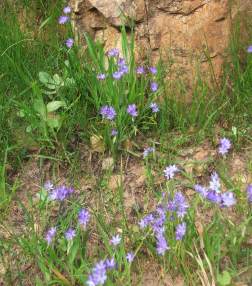Geissorhiza aspera
Geissorhiza aspera Goldblatt
Family: Iridaceae
Common names: blue satin flower (Eng.), blousysie, syblom (Afr.)
Introduction
Geissorhiza aspera. a common sight in spring, is a diminutive little plant with star-like flowers, which floods the veld with shades of blue when grown en masse.

Description
Description
Geissorhiza aspera is a cormous geophyte with sword-shaped leaves. This bulbous plant is 100-350 mm high and the stem is roughly scabrid. The leaves have a lightly thickened midrib and are 2-5 mm wide; the inflorescence is 3- to 7-flowered. Flower colour ranges from deep blue to violet and may have a darker centre; flowers are 11-15 mm long. The best time for flowering is from August to September and the plant seeds readily in October.
Conservation Status
Status
Although considered common, this bulb has only saved itself by becoming naturalized in urban environments. The majority of the populations of Geissorhiza aspera are found along roadsides and park grounds, where it flourishes, due to mowing of grasses and thus reduction in competition plants.

Distribution and habitat
Distribution description
The satin flower has its distribution from Gifberg to Bredasdorp and occurs on flats and slopes between 10-700 m. It prefers moist, sandy soils and usually flowers after good winter rains. Geissorhiza aspera requires a dry summer period and would best suit a rock garden with mass planting.
Derivation of name and historical aspects
History
Geissorhiza is a Greek-derived word, geisson meaning title and rhiza meaning roots, therefore this genus has regular overlapping of the corm tunics. The species name aspera is a Latin-derived word, means rough and refers to the very rough stem. The genus Geissorhiza falls under the family Iridaceae and with Hesperantha falls in the subfamily Crocoideae (=Ixioideae), as they have asymmetric corms. Geissorhiza has 84 species, of which 83 occur in the Cape.
Ecology
Ecology
The star-shaped flowers are pollinated by a variety of insects, but mostly by the monkey beetle (Scarabaeidae: Hopliini) which is attracted to the dark centre of the star. Often the beetles can be seen with their bottoms up in the air and their back legs covered in yellow pollen grains.

Growing Geissorhiza aspera
Grow
This bulb is best suited to a pot display or in an arid rockery and when planted en masse provides a wonderful plate of colour for the spring garden. A winter-growing geophyte, it can be grown in pots to transform a dull courtyard, or the pots can be sunk into the ground in garden beds. Seed can also be broadcast in a secluded bed or rockery and will provide a carpet of lavender blue in the spring.

Geissorhiza aspera can be grown from seed: sow in autumn, from April to May. Seeds are best sown in a mix of 3 parts river sand to 1 part fine, acid compost or finely milled pine bark. Keep the medium moist but not wet and treat with a fungicide if damping off occurs. Corms are planted in the autumn months into pots 15-20 cm in diameter and approximately twice their height. An acid medium is recommended, one that is well drained and will dry out completely in the hot summer months. During the growing season pots can be watered every 10 days, however, as the summer progresses this must be reduced and stopped once plant growth has ceased. Containers should be stored in a cool dry place until the following autumn. Should you plant the corms directly into a flower bed, choose a mole-proof bed, alternatively plant them in a wire basket that can be lifted after the growing season.
Pests of Geissorhiza aspera include thrips and aphids which cause damage to leaves, aphids also transmit viral diseases. In order to prevent further infection of your plants, diseased plants should be removed and burnt. Spraying with a selective insecticide for thrips or aphids can help combat an outbreak of these pests and a spread of viral infections. Slugs and snails are common pests to seedlings and the leaves of young bulbs; a light application of snail bait can solve this. A fungal dry rot can attack the corms too; to prevent this, dust the corms with an antifungal powder and keep in a clean, dry place when storing.
References
- Goldblatt, P. 1981. Systematics of the southern African genus Geissorhiza (Iridaceae-Ixioideae). Annals of the Missouri Botanical Garden 72: 277-447.
- Goldblatt, P. 1989. Geissorhiza callista (Iridaceae). Flowering Plants of Africa 50: 49-52, t. 1996.
- Goldblatt, P. & Manning, J.C. 1995. New species of the southern African genus Geissorhiza (Iridaceae: Ixioideae). Novon 5: 156-161.
- Powrie, F. 1998. Grow South African plants. National Botanical Institute, Cape Town.
- Jeppe, B. 1989. Spring and winter flowering bulbs of the Cape. Oxford University Press, Cape Town.
Credits
Carly Cowell
Kirstenbosch National Botanical Garden
October 2006
Plant Attributes:
Plant Type: Bulb
SA Distribution: Northern Cape, Western Cape
Soil type: Sandy
Flowering season: Spring
PH: Neutral
Flower colour: Blue, Mauve/Lilac
Aspect: Morning Sun (Semi Shade)
Gardening skill: Easy
Special Features:
Horticultural zones







Rate this article
Article well written and informative
Rate this plant
Is this an interesting plant?
Login to add your Comment
Back to topNot registered yet? Click here to register.